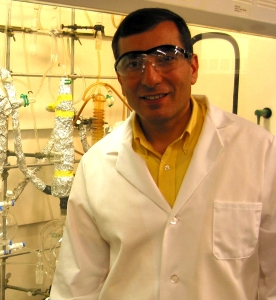Researchers from Rice University in Houston developed a method of growing seamless carbon nanotubes on graphene, with a high surface area and electric conductivity. The team that included members from Tianjin University in China and University of Texas at San Antonio published their findings today in the journal Nature Communications (paid subscription required).
James Tour (pictured right), who holds faculty positions at Rice in chemistry, engineering, and computer science, led the team that combined graphene and nanotubes into a seamless three-dimensional structure. Graphene is a one-atom thick sheet of carbon atoms, light in weight, chemically stable, and can conduct both heat and electricity. The process devised by Tour’s team grows the nanotubes out of the graphene, so they are part of the graphene material, not attached to it.
The researchers first grew graphene on copper, then grew the nanotubes from the graphene. As a result, the electrons flow smoothly from the original graphene to the nanotubes, since the the graphene and nanotubes are one seamless material.
One advantageous property, says Tour, is the high surface area of the material, “more than 2,000 square meters per gram of material. It’s a huge number.” The high surface area makes it desirable for energy storage applications, such as supercapacitors that can store substantially larger numbers of charges, but they have only a fraction of a battery’s energy density.
The new research builds on previous studies by Rice chemist and co-author Robert Hauge that grew densely packed carpets of nanotubes on a carbon substrate by suspending catalyst-laced flakes in a furnace. The new research uses the same iron catalyst and aluminum oxide buffer, but this time are put on top of a layer of graphene grown separately on a copper substrate. The copper acts as a current collector for the three-dimensional hybrid nanotubes that were grown within minutes to lengths of up to 120 microns (1 micron equals 1 millionth of a meter).
Electron microscope images show the nanotubes with one to three walls, embedded in the graphene. Testing showed no resistance to the flow of electric current at the junction of the nanotube and graphene. “The performance we see in this study is as good as the best carbon-based supercapacitors that have ever been made,” says Tour.
Read more:
- Process Developed for Mass Nanotube Semiconductor Assembly
- Rice, NIST to Partner on Nanoscale Carbon Materials Research
- Graphene Layers Used to Build Nanoscale Power Transformer
- Power Cell Converts and Stores Energy in Single Unit
- Scientists Produce Ultralight Carbon Nanotube Material
* * *


 RSS - Posts
RSS - Posts
[…] Process Developed to Grow Carbon Nanotubes on Graphene […]
[…] Process Developed to Grow Carbon Nanotubes on Graphene […]